
2-PENTANONE

1) In the NMR spectrum, we note that there are 4 distinct peaks, so we know that in the molecule, there are four different types of hydrogens.
2) The area of the individual peaks gives the sum of 10, in line with the empirical formula C 5 H 10 O, so the area declared at the top of the peaks corresponds to the number of hydrogen atoms that produce that signal.
3) The molecule C 5 H 10 O contains a double bond, in fact if it were saturated with hydrogens would contain 12 (2n + 2). Because it contains a carbonyl, the double bond is here, the rest of the molecule is saturated.
4) The two signals at d 2.45 and d 2.09 corresponding to the hydrogens on the carbon next to the carbonyl which absorb in the range between d 2 and d 3. The other two peaks at d 0.96 and d 1.61 corresponding to hydrogen instead of carbon primary and secondary respectively.
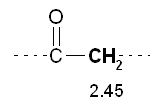 5) The peak 2 at d 2.09 has multiplicity 1 then refers to hydrogens that do not have near no hydrogen (m - 1 0 = H). This confirms the previous inference that the peak is due to a CH 3 near the bunker.
5) The peak 2 at d 2.09 has multiplicity 1 then refers to hydrogens that do not have near no hydrogen (m - 1 0 = H). This confirms the previous inference that the peak is due to a CH 3 near the bunker.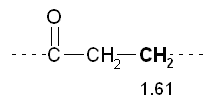 The peak 1 at d 2.45 has multiplicity 3 then refers to hydrogens which have close idogeni 2 (m - 1 = 2 H). This confirms the previous inference that the peak is attributable to a CH 2 near a bunker, and also suggests that there is a further CH 2 tied immediately over.
The peak 1 at d 2.45 has multiplicity 3 then refers to hydrogens which have close idogeni 2 (m - 1 = 2 H). This confirms the previous inference that the peak is attributable to a CH 2 near a bunker, and also suggests that there is a further CH 2 tied immediately over.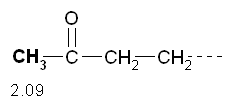 The peak 3 at d 1.61 has multiplicity 6 then refers to hydrogens that are near 5 hydrogens (m - 1 = 5 H). This confirms the previous inference that the peak is due to a CH 2 secondary that has near the two hydrogens of the peak 1 and the other three hydrogen atoms, those of the CH 3terminal.
The peak 3 at d 1.61 has multiplicity 6 then refers to hydrogens that are near 5 hydrogens (m - 1 = 5 H). This confirms the previous inference that the peak is due to a CH 2 secondary that has near the two hydrogens of the peak 1 and the other three hydrogen atoms, those of the CH 3terminal.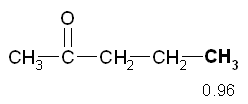 The peak 4 at d 0.96 has multiplicity 3 then refers to hydrogens which have close idogeni 2 (m - 1 = 2 H). This confirms the previous inference that the peak is due to the CH 3 terminal of the molecule.
The peak 4 at d 0.96 has multiplicity 3 then refers to hydrogens which have close idogeni 2 (m - 1 = 2 H). This confirms the previous inference that the peak is due to the CH 3 terminal of the molecule.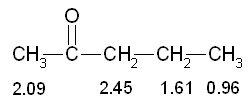 6) The deductions made so far lead us to hypothesize that the NMR spectrum is related to the molecule 2-pentanone which has the structure shown at right:
6) The deductions made so far lead us to hypothesize that the NMR spectrum is related to the molecule 2-pentanone which has the structure shown at right:7) Analyzing the molecule of 2-pentanone we can confirm the assignment of the peaks for both the chemical shift, both for the multiplicity (indicated in the figure in parentheses.)

2-pentanone
IR

MASS

13 CNMR

RAMAN

MASS
13 CNMR
RAMAN
No comments:
Post a Comment